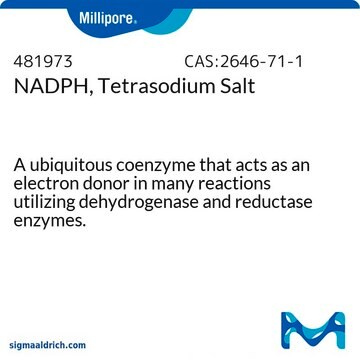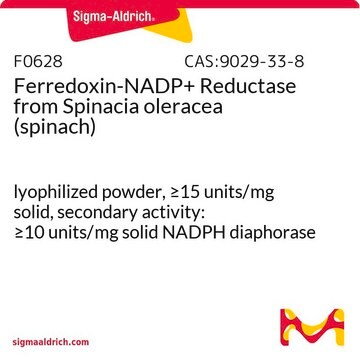No, this product does not contain FAD and is not FAD-dependent. This product is Glucose 1-Dehydrogenase, as such this is an NAD dehydrogenase.
19359
Glucose dehydrogenase from Pseudomonas sp.
powder, white, ≥200 U/mg
Sinónimos:
GDH
Seleccione un Tamaño
Seleccione un Tamaño
About This Item
Productos recomendados
origen biológico
bacterial (Pseudomonas spp.)
Formulario
powder
actividad específica
≥200 U/mg
características de los productos alternativos más sostenibles
Waste Prevention
Design for Energy Efficiency
Learn more about the Principles of Green Chemistry.
sustainability
Greener Alternative Product
color
white
categoría alternativa más sostenible
, Enabling
temp. de almacenamiento
−20°C
Categorías relacionadas
Descripción general
Aplicación
Acciones bioquímicas o fisiológicas
Definición de unidad
Código de clase de almacenamiento
11 - Combustible Solids
Clase de riesgo para el agua (WGK)
WGK 3
Punto de inflamabilidad (°F)
Not applicable
Punto de inflamabilidad (°C)
Not applicable
Equipo de protección personal
Eyeshields, Gloves, type N95 (US)
Elija entre una de las versiones más recientes:
¿Ya tiene este producto?
Encuentre la documentación para los productos que ha comprado recientemente en la Biblioteca de documentos.
-
Does this GDH contain FAD?
1 answer-
Helpful?
-
-
Does this product contain co-factor NADH?
1 answer-
NADH is already present as a cofactor in this product, so there is no need to add it.
Helpful?
-
-
What solvent can Product 19359, Glucose dehydrogenase be dissolved in? How should it be stored?
1 answer-
Glucose Dehydrogenase can be dissolved in a solvent such as a phosphate buffer or Tris-HCl buffer. The product must be stored in a cool, dry and well-ventilated place with the container tightly closed. Recommended Storage temperature is -20°C.
Helpful?
-
Active Filters
Nuestro equipo de científicos tiene experiencia en todas las áreas de investigación: Ciencias de la vida, Ciencia de los materiales, Síntesis química, Cromatografía, Analítica y muchas otras.
Póngase en contacto con el Servicio técnico








